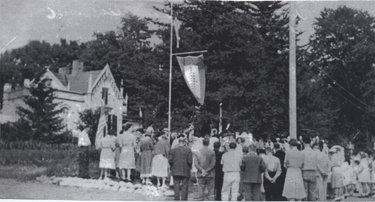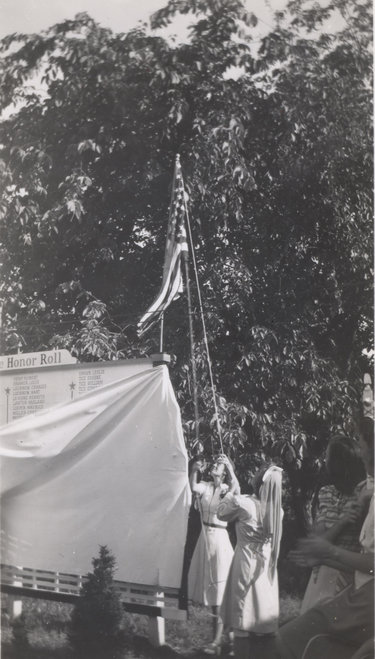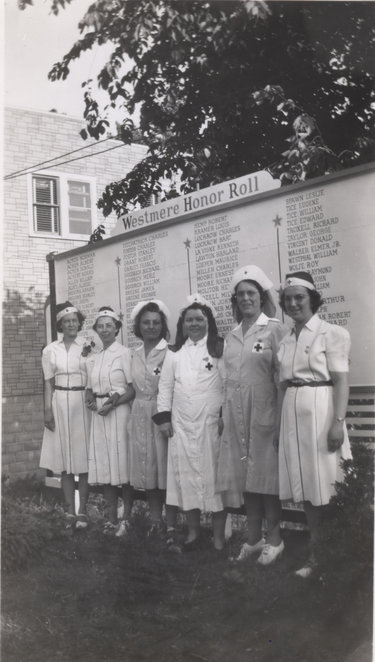World War II: Honoring those in service was a way to raise morale on the home front
— Photo from the Guilderland Historical Society
Guilderland Center’s service flag hung on a special frame above the fire department’s locomotive ring that once called out the community’s firemen to fight a fire. It stood just outside the firehouse in the “old town hall” building on the main street, now Route 146, opposite the Cobblestone School.
— Photo from the Guilderland Historical Society
Some historically minded person not only snapped these photos to record the parade and dedication of Westmere’s Honor Roll, but in addition jotted explanatory notes on the back side of each snapshot. Marching in their dedication parade on Route 20 in 1943 were the Westmere Fire Department Ladies’ Auxiliary and the local Boy Scout troop.
The spring of 1942 found the United States at war with Japan and Germany. Japan, rapidly expanding its empire in the Pacific, was seemingly unstoppable.
The Japanese had not only had battered the American fleet at Pearl Harbor months before, but by early April had forced the surrender of American troops at Bataan in the Philippines, followed a month later by their taking Corregidor. Coming closer to our mainland in June, the Japanese landed in the Aleutians off the coast of Alaska.
In Europe, Adolf Hitler’s armies had occupied most of the continent and were sending endless bombing raids in an attempt to pound Britain into submission. Hitler’s June invasion of the Soviet Union was rapidly advancing. With ever worsening news from abroad, these were dark days for Americans.
In August 1940, with the threat of war looming, President Franklin D. Roosevelt called reservists and National Guard members to active duty, and that September Congress passed the first peacetime draft in our history, for men between the ages of 21 to 35.
By the spring of 1942, every community saw large numbers of its young men volunteering or being drafted. As the war went on, the draft expanded its classifications.
Local families whose sons and sometimes daughters were in the military hung rectangular service flags in a window, the blue stars representing their family members in the military and, as the tragic toll of war mounted, gold stars for family members killed in the war.
Communities, feeling the absence of so many of their young men and wanting to recognize their service, began displaying service flags and erecting wooden plaques or honor rolls in a public place for all to see. The honor rolls listed the names of all the local men and the occasional women who were in the armed forces.
Private Orsini MIA
as Altamont honors servicemen
The May 29, 1942 Enterprise had two front-page headlines, one reading “Honor Roll Plaque To Be Placed in Park, Plan Parade, Addresses,” while adjoining it was the lead headline “Altamont Man In Corregidor Area, When Island Fell/ War Dept. Waits Word From Japanese For Names of Prisoners Taken.”
The young Altamont man was Private Millard Orsini. Scheduled for June 21 in the park, the committee had already begun planning a parade and dedication ceremony, including all ages and groups, particularly recognizing the mothers of servicemen by seating them at the front of the dedication ceremony.
With the fate of the young Orsini serviceman hanging in the balance, Altamont’s dedication was probably the most emotional of all the local dedications.
On dedication day, the parade started from the fairgrounds down Grand Street to the Main Street, right on Lincoln Avenue, over to Western Avenue and then across Maple Avenue past the reviewing stand there and over to Depot Square and the park. Along the route, all the homeowners had been requested to display their American flags.
Four divisions marched in the parade, the first including Grand Marshall John Walker, a World War I veteran who had fought with the British and was a member of the Helderberg Post American Legion, followed by the ceremony speakers, village trustees, color guard, the British Empire War Veterans Kiltie Band, American Legion and its auxiliary, Red Cross members and their ambulance, Army jeeps and their representatives.
The second division had the Altamont Fire Department members and auxiliary and other groups. The third division was headed by the chief air-raid warden and included the Altamont High School Band, air-raid wardens, and fraternal and civic groups. The fourth division was led by the chairman of the local Boy Scout committee, leading Boy Scout and Girl Scout units.
Once at the park, the large honor roll plaque was unveiled and dedicated. It listed 52 names with space for additional names to be added as the war continued.
The ceremony began and ended with invocation and benediction by Altamont’s two Protestant ministers with additional words from a LaSalette priest. A local woman sang “America,” followed by a welcome from the village mayor.
The actual dedication was led by Margaret Rickard and Ken Orsini, assisted by Margaret Orsini, Mary Rau, and the color guard. After the president of the fire department read off the names on the honor roll, General Ames T. Brown was the principal speaker. Mothers of servicemen were presented with service pins at the end of the ceremony.
Hamlet has plaque
on church lawn
July 1942 brought other honor-roll dedications in Guilderland’s communities.
Hamlet of Guilderland residents gathered on the lawn of the Presbyterian Church for the dedication of their honor-roll plaque, listing the names of 26 men in that election district. Both the plaque and a service flag with stars representing the 26 men had been erected on a corner of the Magill property next door to the church.
Today we know this as the Schoolcraft House, but the Magills lived there for many years in the 20th Century. There was no parade, but a dedication service was held in front of the plaque.
Opening the program, the orchestra of the Federated Sunday School played a march, followed by an invocation given by the Federated Presbyterian Church’s Rev. DeGraff and two solos, “America” and “Recessional” were sung.
Guilderland Center’s Rev. W.D. Worman of St. Mark’s Lutheran Church offered a prayer, then remarks were made by Aaron Bradt, a Spanish-American War veteran, and Rev. DeGraff offered a prayer.
The Home Bureau presented to the community a service flag that was accepted by Guilderland’s fire chief. To one side of the honor-roll plaque had been erected a flag pole to hold an American flag with the service flag hanging horizontally.
Next, many community organizations marched to the honor-roll plaque: Boy Scouts and Girls Scouts, a color guard, Sunday School children carrying flags, relatives of servicemen, Home Bureau members, the Red Cross, the Order of Red Men and their Pocahontas auxiliary (this was a fraternal organization based in the hamlet).
Next, the director of the Girl Scouts, assisted by her brother-in-law, a naval storekeeper third class, unveiled the honor-roll plaque. A Boy Scout presented the American flag and a Girl Scout presented the 26-star service flag, which were then raised by a member of the Order of Red Men. The ceremony concluded with Rev. Worman offering benediction.
Parade starts
Guilderland Center ceremony
The next weekend, Guilderland Center dedicated a service flag sponsored by its fire department. The event began with a parade headed by the 50-piece Roesselville Band (this high school preceded Colonie Central High School).
As he had been in Altamont, World War I veteran John Walker had been invited to be Grand Marshall.
In front of the Cobblestone School, an invocation given by Helderberg Reformed Church’s Rev. James Moffit was followed by a solo of “America,” a welcome, then the guest speaker Past Commander of the Albany County American Legion, followed by a few words from Fr. Dillon of LaSalette Seminary.
The main address was made by Col. John Chambliss, the officer in charge of the Voorheesville Holding and Reconsignment Point (the official name of the Army Depot).
Then the service flag was presented and the names of those on the roll of honor were read, a bugle call to the colors sounded out, and the audience recited the Pledge of Allegiance. The flag was formally accepted for the community.
Then auxiliary members of the Guilderland Center Fire Department presented service pins to mothers of servicemen and the dedication service culminated in the singing of “The Star Spangled Banner” and a benediction offered by Rev. Worman of St. Mark’s Lutheran Church.
In Westmere: A promise to
‘have a good America waiting’
The community of Westmere dedicated its own honor-roll plaque in June of 1943, recognizing the 90 men from that fire district serving in the armed forces with a parade on Route 20 and a ceremony at the Westmere firehouse.
It was noted that this was the first time in history a parade had been held in Westmere.
One of the speakers was the Albany chairman of the Joint War Veterans’ Advisory Board who looked to the future saying, “Let us promise those men in uniform that we will have a good America waiting when they return … .”
The president of the Albany Chamber of Commerce also spoke, warning the present war is “an all-out struggle for our way of life.” Reverend Carothers had opened the ceremonies with a prayer and town Supervisor Earle B. Conklin of McKownville also spoke.
Honor rolls grow
In Altamont, July 4, 1943 was marked with a parade and rededication of their honor-roll plaque, which was so filled with names that two side panels had to be added to provide space to list nearly three times the number of the original names.
The list given in The Enterprise article included one man who had died in service; one woman; and, next to Millard Orsini’s name: “held prisoner by the Japanese according to report of the International Red Cross.”
One of the seven Orsini brothers who fought in World War II, Millard survived the war and came home to Altamont. The American flag he fashioned as a prisoner of war, risking his life to do it, is now displayed at Altamont’s Home Front Café.
Two flag poles had been donated, one for an American flag and the other for a service flag erected on each side of the now expanded plaque. A man volunteered to repaint the weathered names on the original plaque and add the new names.
The rededication ceremony was similar to previous ones with clergy, civic groups, the Altamont High School Band, and officials taking part. Later that year and again in 1944, notices appeared urging anyone knowing of an armed-forces member from that vicinity not listed to make officials aware so his name could be added.
In 1944, Guilderland Center folks were raising money to enlarge the service plaque, while in Guilderland the Home Bureau was raising money to get new flags and enlarge its honor-roll plaque. If McKownville had an honor roll or service flag, there seemed to be no mention of it in The Enterprise.
These patriotic dedication parades and ceremonies served not only to honor and support the men and women in the armed forces, but also to raise morale on the home front. As members of the community came together, the ceremonies fueled their determination, no matter their ages, to do what it would take to win the war.








